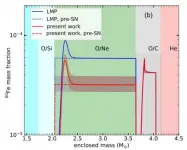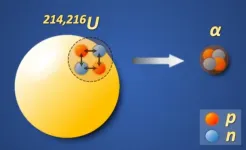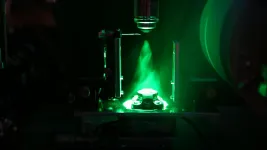(Press-News.org) EUGENE, Ore. -- April 16, 2021 -- University of Oregon physicists have developed a new method to manipulate sound -- stop it, reverse it, store it and even use it later -- in synthetic composite structures known as metamaterials.
The discovery was made using theoretical and computational analysis of the mechanical vibrations of thin elastic plates, which serve as the building blocks for the proposed design. The physicists, Pragalv Karki and Jayson Paulose, also developed a simpler minimal model consisting of springs and masses demonstrating the same signal manipulation ability.
"There have been a lot of mechanisms that can guide or block the transmission of sound waves through a metamaterial, but our design is the first to dynamically stop and reverse a sound pulse," said Karki, a postdoctoral researcher in the UO's Department of Physics and Institute for Fundamental Science.
The interplay between bending stiffness and the global tension --two physical parameters governing sound transmission in thin plates--is at the heart of their signal-manipulation mechanism. While bending stiffness is a material property, global tension is an externally controllable parameter in their system.
Karki and Paulose, an assistant professor of physics and member of the Institute for Fundamental Science, described their new mechanism, which they call dynamic dispersion tuning, in a paper published online March 29 in the journal Physical Review Applied.
"If you throw a stone onto a pond, you see the ripples," Karki said. "But what if you threw the stone and instead of seeing ripples propagating outward you just see the displacement of the water going up and down at the point of impact? That's similar to what happens in our system."
The ability to manipulate sound, light or any other waves in artificially made metamaterials is an active area of research, Karki said.
Optical or photonic metamaterials, which exhibit properties such as a negative refractive index not possible with conventional materials, were initially developed to control light in ways that could be used to create invisibility cloaks and super lenses.
Their use is being explored in diverse applications such as aerospace and defense, consumer electronics, medical devices and energy harvesting.
Acoustic metamaterials are usually static and unchangeable once produced, and dynamically tuning their properties is an ongoing challenge, Karki said. Other research groups have proposed several strategies for tuning acoustic transmission, ranging from origami-inspired designs to magnetic switching.
"In our case, the tunability comes from the ability to change the tension of the drum-like membranes in real time," Karki said.
Additional inspiration, Karki and Paulose noted, came from research in the UO lab of physicist Benjamín Alemán. In Nature Communications in 2019, Alemán's group unveiled a graphene nanomechanical bolometer, a drum-like membrane that can detect colors of light at high speeds and high temperatures. The approach exploits a change in global tension.
While the mechanism in the new paper was identified theoretically and needs to be proven in lab experiments, Karki said, he is confident the approach will work.
"Our mechanism of dynamic dispersion tuning is independent of whether you are using acoustic, light or electronic waves," Karki said. "This opens up the possibility of manipulating signals in photonic and electronic systems as well."
Possibilities, he said, include improved acoustic signal processing and computation. Designing acoustic metamaterials based on graphene, such as those developed in Alemán's lab, could lead to variety of uses like wave-based computing, micromechanical transistors and logic devices, waveguides and ultra-sensitive sensors.
"Our design could be built at the microscale with graphene and at large scales using drum-like membrane sheets," Karki said. "You strike the chain of drums, creating a particular pattern of sound that moves in one direction, but by tuning the tension of the drums, we can stop the sound and store it for future use. It can be reversed or manipulated into any number of other patterns."
INFORMATION:
Links:
Paper: https://doi.org/10.1103/PhysRevApplied.15.034083
About Jayson Paulose: https://ifs.uoregon.edu/profile/jpaulose/
Paulose's research program: https://pages.uoregon.edu/jpaulose/
Department of Physics: https://physics.uoregon.edu/
Institute for Fundamental Science: https://ifs.uoregon.edu/
Aleman lab discovery leads to ultrasensitive way to measure light: https://around.uoregon.edu/content/discovery-leads-ultrasensitive-way-measure-light
NEW YORK, NY (April 16, 2021)--SARS-CoV-2, the virus that causes COVID-19, likely does not directly infect the brain but can still inflict significant neurological damage, according to a new study from neuropathologists, neurologists, and neuroradiologists at Columbia University Vagelos College of Physicians and Surgeons.
"There's been considerable debate about whether this virus infects the brain, but we were unable to find any signs of virus inside brain cells of more than 40 COVID-19 patients," says James E. Goldman, MD, PhD, professor of pathology & cell biology (in psychiatry), who led the ...
Understanding the components that control cell division is fundamental to understanding how life works and how alterations in this delicate process can cause diseases such as cancer. It was precisely the discoveries of "key regulators of the cell cycle" and their implications for processes such as cancer, that won the British scientists R. Timothy Hunt and Paul M. Nurse and the American scientist Leland H. Hartwell the 2001 Nobel Prize in Physiology or Medicine. A study led by Óscar Fernández-Capetillo, Head of the Genomic Instability Group at the Spanish National Cancer Research Centre (CNIO) and published this week in The EMBO Journal uncovers a new cell cycle control element, the USP7 protein. It acts as a brake to prevent cells ...
Researchers from the Institute of Modern Physics (IMP) of the Chinese Academy of Sciences and their collaborators have recently made great progress in the study of the stellar beta-decay rate of 59Fe, which constitutes an important step towards understanding 60Fe nucleosynthesis in massive stars. The results were published in Physical Review Letters on April 12.
Radioactive nuclide 60Fe plays an essential role in nuclear astrophysical studies. It is synthesized in massive stars by successive neutron captures on a stable nucleus of 58Fe and, during the late stages of stellar evolution, ejected into space via a core-collapse supernova.
The characteristic gamma lines associated with the decay of 60Fe have been detected by space gamma-ray detectors. By comparing the 60Fe ...
The first photosynthetic oxygen-producing organisms on Earth were cyanobacteria. Their evolution dramatically changed the Earth allowing oxygen to accumulate into the atmosphere for the first time and further allowing the evolution of oxygen-utilizing organisms including eukaryotes. Eukaryotes include animals, but also algae, a broad group of photosynthetic oxygen-producing organisms that now dominate photosynthesis in the modern oceans. When, however, did algae begin to occupy marine ecosystems and compete with cyanobacteria as important phototrophic organisms?
In a new study Zhang et al use the molecular remains of ancient algae (so-called biomarkers) to show that algae occupied an important ...
It is always exciting to find new isotopes with extreme neutron/proton numbers in nuclear physics research. In the region of heavy nuclei, α-decay is one of the pervasive decay modes and plays an essential role in searching for new isotopes. However, even after about a century of studying α-decay, scientists still cannot perfectly describe how the α-particle is formed at the surface of the nucleus before its emission.
In the α-decay process, the α-particle can be regarded not only as two protons plus two neutrons, but also as two proton-neutron pairs. Although previous studies have proved the importance of the pairing forces between the identical nucleons, it remains unclear whether ...
Older adults are more willing to make an effort to help others than younger adults, according to new research from the University of Birmingham.
The study, led by researchers in the University's School of Psychology, is the first to show how effortful 'prosocial' behaviour - intended to benefit others - changes as people get older. In particular, it focused on people's willingness to exert physical effort, rather than to give money or time, since attitudes to both these are known to change with age. The research results are published in Psychological Science.
In the study, the research team tested a group of 95 adults aged between 18 and 36, and a group of 92 adults aged 55-85. Each participant made 150 choices about whether or not to grip a handheld ...
WASHINGTON, April 16, 2021 -- Early in the COVID-19 pandemic, doctors recognized that patients who developed a "cytokine storm" -- a surge of pro-inflammatory immune proteins -- were often the sickest and at highest risk of dying. But a cytokine storm can also occur in other illnesses, such as influenza. Today, scientists report preliminary results on a sweat sensor that acts as an early warning system for an impending cytokine storm, which could help doctors more effectively treat patients.
The researchers will present their results today at the spring meeting of the American Chemical Society (ACS). ACS Spring 2021 is being held online April 5-30. Live sessions will be hosted April 5-16, ...
Encoding information into light, and transmitting it through optical fibers lies at the core of optical communications. With an incredibly low loss of 0.2 dB/km, optical fibers made from silica have laid the foundations of today's global telecommunication networks and our information society.
Such ultralow optical loss is equally essential for integrated photonics, which enable the synthesis, processing and detection of optical signals using on-chip waveguides. Today, a number of innovative technologies are based on integrated photonics, including semiconductor ...
Researchers at Aalto University have developed a new device for spintronics. The results have been published in the journal Nature Communications, and mark a step towards the goal of using spintronics to make computer chips and devices for data processing and communication technology that are small and powerful.
Traditional electronics uses electrical charge to carry out computations that power most of our day-to-day technology. However, engineers are unable to make electronics do calculations faster, as moving charge creates heat, and we're at the ...
Vitamin D deficiency may impair muscle function due to a reduction in energy production in the muscles, according to a mouse study published in the Journal of Endocrinology. Vitamin D deficient mice were found to have impaired muscle mitochondrial function, which may have implications for muscle function, performance and recovery. This may suggest that preventing vitamin D deficiency in older adults could help maintain better muscle strength and function and reduce age related muscle deterioration, but further studies are needed to confirm this.
Vitamin D is a hormone well known to be important for maintaining bone health and preventing ...






